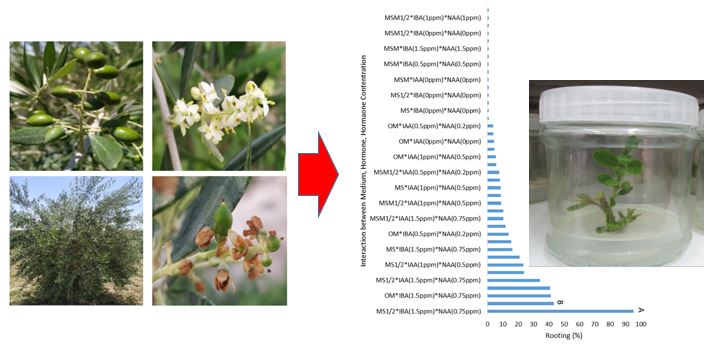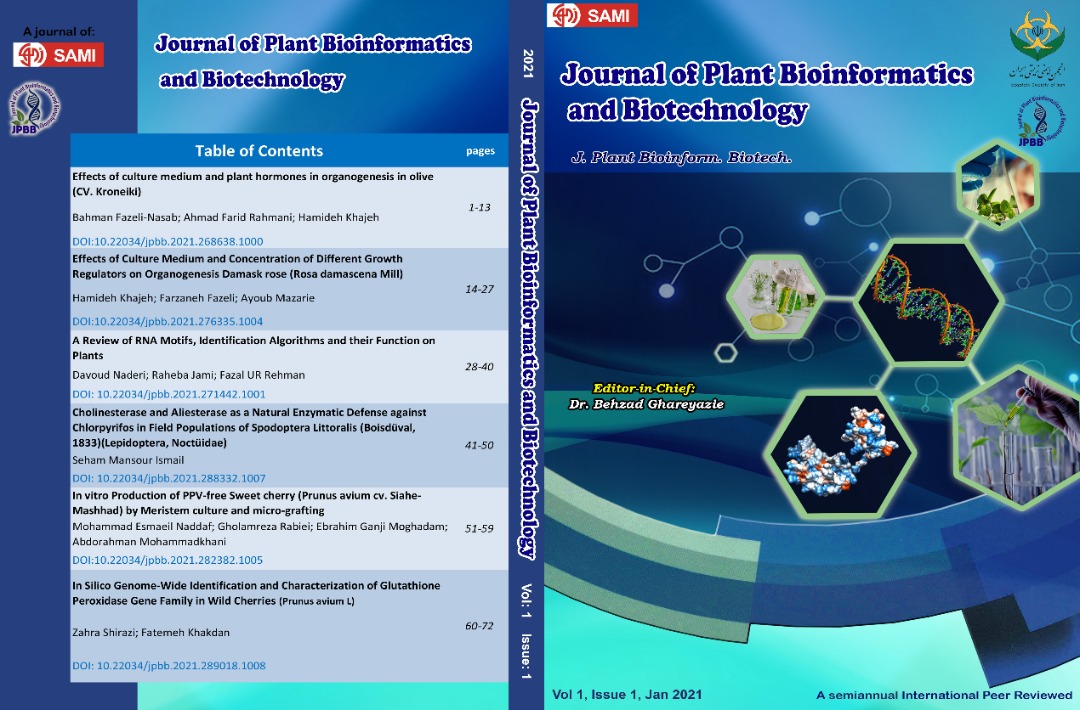1. peyvandi m, farahzadi h n, arbabiyan s, hoseynimazinani m. (2010). Effects of medium on somatic embryogenesis of Olea europea L. (cv. Kroneiki). Iranian Journal of Rangelands and Forests Plant Breeding and Genetic Research, 18(1): 93-101.
2. Ghane Golmohamadi F, Hosseini R, Morad Nezhad M. (2019). Investigating the effect of simultaneous application of red LED and sodium dikegulac on shoot regeneration and longitudinal growth of olive (Olea europaea L.) cv. Zard explants. Iranian Journal of Plant Biology, 11(1): 81-96. https://doi.org/10.22108/ijpb.2019.110506.1091
3. Rugini E, Tarini P. (1986). Somatic embryogenesis in olive tree (Olea europaea L.). Paper presented at the Arbres Fruitiers et Biotechnologies. Paris (France). 14-15 Oct 1986.
4. Jain S M, Ochatt S J. (2010). Protocols for in vitro propagation of ornamental plants (Vol. 589): Springer. https://doi.org/10.1007/978-1-60327-114-1
5. Jokari S, Hedayat M. (2017). Effect of growth regulators on proliferation ber four (Ziziphus spp.) In vitro culture. Journal of Plant Research (Iranian Journal Of Biology), 30(3): 531-540.
6. George E F, Hall M A, De Klerk G-J. (2008). Plant growth regulators II: cytokinins, their analogues and antagonists Plant propagation by tissue culture (pp. 205-226): Springer. https://doi.org/10.1007/978-1-4020-5005-3_6
7. Lone S M, Hussain K, Malik A, Magray M, Hussain S M, Rashid M, Farwah S. (2020). Plant Propagation through Tissue Culture–A Biotechnological Intervention. Int. J. Curr. Microbiol. App. Sci, 9(7): 2176-2190. https://doi.org/10.20546/ijcmas.2020.907.254
8. Kaviani B, Hesar A A, Kharabian-Masouleh A. (2011). In vitro propagation of Matthiola incana (Brassicaceae)-an ornamental plant. Plant Omics J, 4(7): 435-440.
9. Murashige T, Skoog F. (1962). A revised medium for rapid growth and bio assays with tobacco tissue cultures. Physiologia plantarum, 15(3): 473-497.
10. Leva A. (2011). Innovative protocol for “ex vitro rooting” on olive micropropagation. Central European Journal of Biology, 6(3): 352-358. https://doi.org/10.2478/s11535-011-0010-3
11. Mencuccini M, Rugini E. (1993). In vitro shoot regeneration from olive cultivar tissues. Plant cell, tissue and organ culture, 32(3): 283-288. https://doi.org/10.1007/BF00042290
12. Ahmed E E, Bisztray G, Velich I. (2002). Plant regeneration from seedling explants of common bean (Phaseolus vulgaris L.). Acta Biologica Szegediensis, 46(3-4): 27-28.
13. Karami M, Bagherieh-Najjar M B, Aghdasi M. (2013). Optimization of conditions suitable for bean (Phaseolus vulgaris L.) regeneration. Journal of Plant Biology, 5(15): 1-14.
14. Reis E, Batista M T, Canhoto J M. (2008). Effect and analysis of phenolic compounds during somatic embryogenesis induction in Feijoa sellowiana Berg. Protoplasma, 232(3-4): 193-202. 10.1007/s00709-008-0290-2
15. Sobhanizadeh A, Solouki M, Fazeli Nasab B. (2016). Kinetin impact on the growth rate of Black Cumin under salt stress. Secound International Conference on Agriculture, Natural Resources, Environment and medicinal plants, Iran.
16. Shahadati-Moghadam Z. (2001). Plant growth regulators. master's seminar, the University of Mazandaran.
17. Fazeli-Nasab B, Masour O, Mehdi A. (2012). Estimate of callus induction and volume immature and mature embryo culture and respons to in-vitro salt resistance in presence of NaCL and ABA in salt tolerant wheat cultivars. Int. Agric. Crop Sci, 4(1): 8-16.
18. Elaleem K G A, Modawi R S, Khalafalla M M. (2009). Effect of plant growth regulators on callus induction and plant regeneration in tuber segment culture of potato (Solanum tuberosum L.) cultivar Diamant. African journal of biotechnology, 8(11).
19. JayaSree T, Pavan U, Ramesh M, Rao A, Reddy K J M, Sadanandam A. (2001). Somatic embryogenesis from leaf cultures of potato. Plant cell, tissue and organ culture, 64(1): 13-17.
20. Ahmad N, Fazal H, Zamir R, Khalil S A, Abbasi B H. (2011). Callogenesis and shoot organogenesis from flowers of Stevia rebaudiana (Bert.). Sugar tech, 13(2): 174-177.
21. Hohtola A. (1988). Seasonal changes in explant viability and contamination of tissue cultures from mature Scots pine. Plant cell, tissue and organ culture, 15(3): 211-222. doi: 10.1007/BF00033645
22. Taha H, El-Bahr M, Seif-El-Nasr M. (2009). In vitro studies on Egyptian Catharanthus roseus (L.) G. Don. IV: manipulation of some amino acids as precursors for enhanced of indole alkaloids production in suspension cultures. Australian Journal of Basic and Applied Sciences, 3(4): 3137-3144.
23. Hussain Z, Khan M H, Bano R, Rashid H, Chaudhry Z. (2010). Protocol optimization for efficient callus induction and regeneration in three Pakistani rice cultivars. Pak. J. Bot, 42(2): 879-887.
24. Piri K h, Nazarian F. (2001). Plant Tissue Culture. Abu Ali Sina University Press.: 352 Pages.
25. Saravanan S, Nadarajan N. (2005). Effect of Media Supplements on in vitro response of Sesame (Sesamum indicum L.) Genotypes. Res J Agric Biol Sci, 1: 98-100.
26. Baskaran P, Jayabalan N. (2006). In vitro mass propagation and diverse callus orientation on Sesamum indicum L. an important oil plant. Journal of Agricultural Technology, 2: 259-269.
27. Rodriguez R. (1982). Callus Induction and Root-Formation from Invitro Culture of Walnut Cotyledons. HortScience, 17(2): 195-196.
28. Mehrabi A-A, Fazeli-Nasab B. (2012). In vitro culture of Allium scorodoprasum spp. Rotundum: callus induction, somatic embryogenesis and direct bulblet formation. Intl. J. Agri. Crop Sci, 4(1): 1-7.
29. Fazelienasab B, Omidi M, Amiritokaldani M. (2004). Effects of abscisic acid on callus induction and regeneration of different wheat cultivars to mature embryo culture. News directions for a diverse planet: Proceedings of the 4th International Brisbane, Australia, 26.
30. Sobhanizade A, Solouki M, Fazeli-Nasab B. (2017). Optimization of callus induction and effects of biological and non-biological elicitors on content of phenol/flavonoid compounds in Nigella sativa under in-vitro conditions. Cell and Tissue Journal, 8(2): 165-184.
31. Murashige T. (1980). Plant growth substances in commercial uses of tissue culture Plant Growth Substances 1979 (pp. 426-434): Springer.
32. Ahmadi A, Kavoosi M R, Soltanloo H, Salehi Jozani G, Sattarian A. (2019). Investigating callus induction and regeneration of Zelkova carpinifolia forest species In vitro. Journal of Plant Research (Iranian Journal Of Biology), 32(1): 16-27.
33. Motaghi M, Mokhtari A. (2019). The determination of optimal condition for micro propagation of Cratagus aronia under in vitro culture. Journal of Plant Research (Iranian Journal Of Biology), 32(1): 39-51.
34. Fazelienasab B, Omidi M, Amiritokaldani M. (2004). Effects of abscisic acid on callus induction and regeneration of different wheat cultivars to mature embryo culture.-4th Int. Crop Sci. Congr. Brisbane, Australia, 26.
35. Fazeli-Nasab B, Omidi M, Amiritokaldani M. (2012). Callus induction and plant regeneration of wheat mature embryos under abscisic acid treatment. Int J Agric Crop Sci, 4: 17-23.
36. Gökbunar L. (2007). In vitro micropropagation of hawthorn (Crataegus sp.). University of Kahramanmaras Sutcu Imam Institute of Natural and Applied Sciences, Department of Horticulture (M.sc Thesis), 42.
37. Singh A, Reddy M P, Chikara J, Singh S. (2010). A simple regeneration protocol from stem explants of Jatropha curcas—a biodiesel plant. Industrial Crops and products, 31(2): 209-213. https://doi.org/10.1016/j.indcrop.2009.10.007
38. Donmez A A. (2004). The genus Crataegus L.(Rosaceae) with special reference to hybridisation and biodiversity in Turkey. Turkish Journal of Botany, 28(1-2): 29-37.
39. Bujarska-Borkowska B. (2002). Breaking of seed dormancy, germination and seedling emergence of the common hawthorn (Crataegus monogyna Jacq.). Dendrobiology, 47(47 Supplement): 61-70.
40. Sharma S, Ramamurthy V. (2000). Micropropagation of 4-year-old elite Eucalyptus tereticornis trees. Plant Cell Reports, 19(5): 511-518. https://doi.org/10.1007/s002990050765
41. Negahdar N. (2019). Micropropagation of Buxus hyrcana Pojark., an ornamental species under danger of extinction. Journal of Plant Research (Iranian Journal Of Biology), 32(2): 332-342.
42. Khawar K, Sarhin E, Sevimay C, Cocu S, Parmaksiz I, Uranbey S, Ipek A, Kaya M, Sancak C, Ozcan S. (2005). Adventitious shoot regeneration and micropropagation of Plantago lanceolata L. Periodicum Biologorum, 107(1): 113-116.
43. Neibaur I, Gallo M, Altpeter F. (2008). The effect of auxin type and cytokinin concentration on callus induction and plant regeneration frequency from immature inflorescence segments of seashore paspalum (Paspalum vaginatum Swartz). In Vitro Cellular & Developmental Biology-Plant, 44(6): 480.
44. Schultz W, Hose S, AbonMandou R A, Czygan F C. (1990). Melissa officinalis L. (Lemon balm), Invitro culture and the production and analysis of volatile compounds. Biotechnology in agriculture and forestry, 24: 242.


